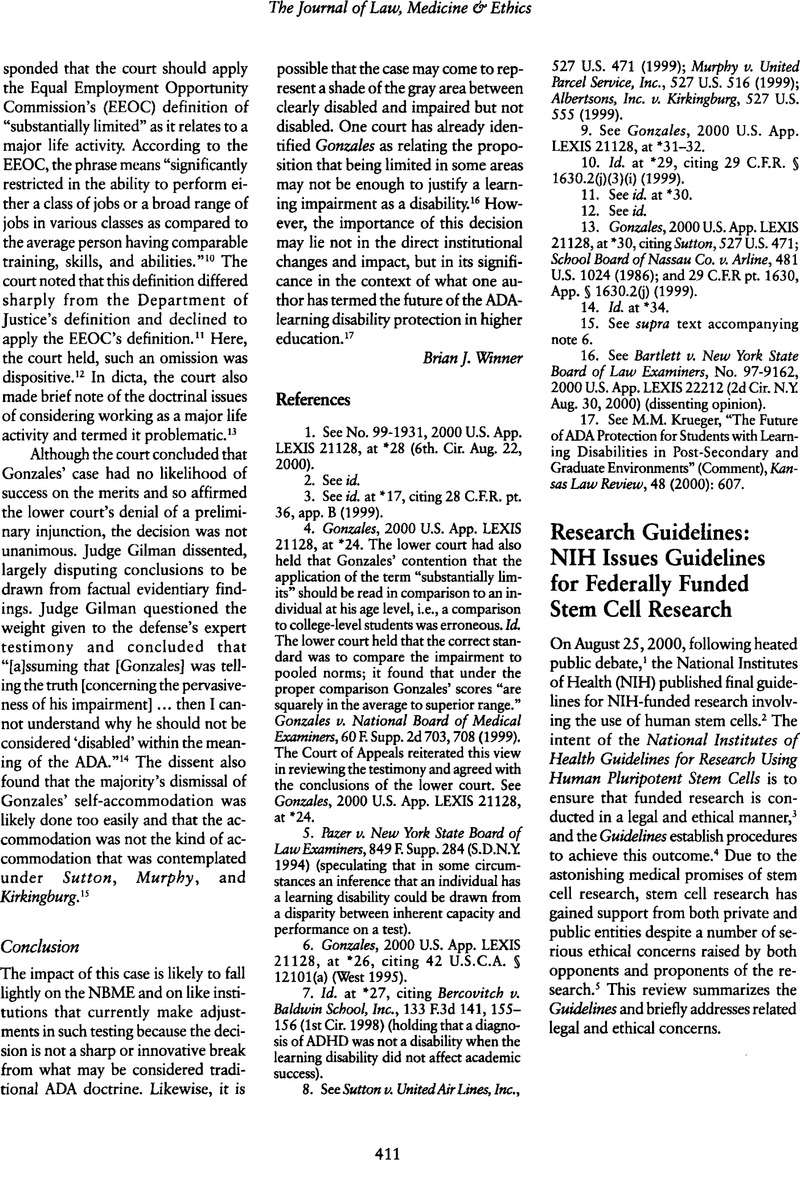No CrossRef data available.
Article contents
Research Guidelines: NIH Issues Guidelines for Federally Funded Stem Cell Research
Published online by Cambridge University Press: 01 January 2021
Abstract
An abstract is not available for this content so a preview has been provided. Please use the Get access link above for information on how to access this content.

- Type
- Article
- Information
- Copyright
- Copyright © American Society of Law, Medicine and Ethics 2000
References
During the public comment phase, NIH received approximately 50,000 comments. These ranged from suggestions that there is no need for any such federal guidelines to contentions that the research was in violation of the U.S. Department of Health and Human Services (DHHS) appropriations law prohibiting research involving human embryos. Comments came from a wide variety of persons and entities, including private citizens, members of Congress, religious organizations, and scientific societies. See “Summary of Public Comments on Draft Guidelines,” National Institutes of Health Guidelines for Research Using Human Pluripotent Stem Cells (visited October 6, 2000) <http://www.nih.gov/news/stemcell/stemcellguidelines.htm>..>Google Scholar
“National Institutes of Health Guidelines for Research Using Human Pluripotent Stem Cells,” 65 Fed. Reg. 51,975, Aug. 25, 2000; BNA's Health Law Reporter, 9 (2000): At 1350 [hereinafter cited as Guidelines].Google Scholar
See, e.g., “Testimony on Pluripotent Stem Cell Research Guidelines” (reporting testimony of two National Institutes of Health directors before the Senate Appropriations Subcommittee on Sep. 7, 2000) (visited October 6, 2000) <http://www.ninds.nih.gov/about_ninds/testimony_stemcell_090700.htm>..>Google Scholar
See, for example, Ethical Issues in Human Stem Cell Research, Executive Summary of the National Bioethics Advisory Commission (September 1999) (visited October 11, 2000) <http://bioethics.gov/stemcell_exec_intro.htm>..>Google Scholar
For a review of stem cell basics, see Pluripotent Stem Cells: A Primer (May 2000) (visited Oct. 6, 2000) <http://www.nih.gov/news/stemcell/primer.htm>..>Google Scholar
For further discussion of stem cell research and potential applications, see “Statement of Harold Varmus, M.D., Director, National Institutes of Health” before the Senate Appropriations Subcommittee on Labor, Health and Human Services, Education and Related Agencies, December 2, 1998 (visited Oct. 6, 2000) <http://nih.gov/news/stemcell/statement.htm>..>Google Scholar
See the “Scope of Guidelines and General Issues” section of the Guidelines, supra note 2.Google Scholar
See Guidelines, supra note 2.Google Scholar
The Guidelines list more than 15 procedural directives for the conduct of funded research. These are summarized in the text above or may be read in full in the Guidelines themselves. See Guidelines, supra note 2.Google Scholar
There also must be a clear separation of the decision to undergo fertility treatment from the decision to donate excess embryos for research.Google Scholar
Standard procedural safeguards include institutional review board (IRB) scrutiny and the provision of documentation and assurances of compliance.Google Scholar
See Guidelines, supra note 2.Google Scholar
See Biven, M., “Administrative Developments: NIH Backs Federal Funding for Stem Cell Research,” Journal of Law, Medicine & Ethics, 27, no. 1 (1999): At 96–97.Google Scholar
The main issue is whether the embryo is a fully realized human with accompanying rights or a potential human whose full rights begin at some point later in pregnancy or at birth.Google Scholar
See, for example, Senate Health Appropriations Subcommittee Hearings, April 26, 2000. See also “Testimony on Pluripotent Stem Cell Research Guidelines, September 2000,” reporting the testimony of two NIH directors before the Senate Appropriations Subcommittee, September 7, 2000 (visited October 6, 2000) <www.ninds.nih.gov/about_ninds/testimony_stemcell_090700.htm>..>Google Scholar
Opponents often characterize proponents' arguments as “utilitarian” at best and have compared stem cell research to medical experiments conducted by the Nazis in World War II, as in this comment by Senator Sam Brownback (R-KS): “… like what happened in World War II. [The Nazis figured that] these people are going to be killed, why not experiment on them ….” See Senate Health Appropriations Subcommittee Hearings, April 26, 2000. See also Irving, D., “Stem Cell Research: Some Pros and Cons,” Canadian Physicians for Life (visited Oct. 11, 2000) <http://physiciansforlife.ca/stemcell1.html>.Google Scholar
Certain additional research areas are also defined as ineligible. See Guidelines, supra note 2.Google Scholar




